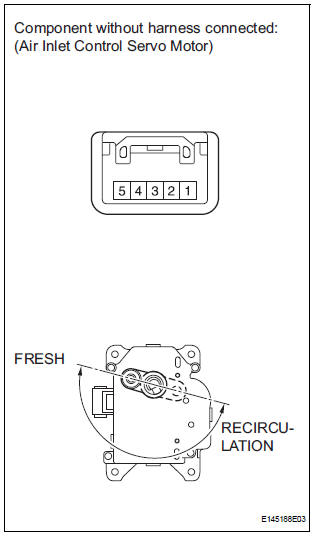Toyota Sienna Service Manual: For manual air conditioning system
ON-VEHICLE INSPECTION
1. INSPECT AIR INLET CONTROL SERVO MOTOR

(a) Remove the air inlet control servo motor.
(b) Connect the positive (+) lead from the battery to terminal 5 and negative (-) lead to terminal 1, then check that the lever turns to "RECIRCULATION" side smoothly.
(c) Connect the positive (+) lead from the battery to terminal 5 and negative (-) lead to terminal 2, then check that the lever turns to "FRESH" side smoothly.
NOTICE: While using the battery during inspection, do not bring the positive and negative tester probes too close to each other as a short circuit may occur.
If the operation is not as specified, replace the air inlet control servo motor.
 For automatic air conditioning system
For automatic air conditioning system
ON-VEHICLE INSPECTION
1. INSPECT AIR INLET CONTROL SERVO MOTOR
(a) Remove the air inlet control servo motor.
(b) Connect the positive (+) lead from the battery to
terminal 4 and negative (-) ...
 Air outlet control servo motor
Air outlet control servo motor
ON-VEHICLE INSPECTION
1. INSPECT AIR OUTLET CONTROL SERVO MOTOR
(a) Remove the air outlet control servo motor.
(b) Connect the positive (+) lead from the battery to
terminal 4 and negative ( ...
Other materials:
Dtc check / clear
1. DTC CHECK/CLEAR (WHEN USING SST CHECK WIRE):
(a) DTC check
(1) Using SST, connect terminals TC and CG of the
DLC3.
SST 09843-18040
(2) Turn the ignition switch to the ON position.
(3) Read the DTCs from the ABS warning light on
the combination meter.
HINT:
If no code appears, inspe ...
Components
REMOVAL
1. DISCONNECT CABLE FROM NEGATIVE BATTERY
TERMINAL
2. REMOVE FRONT BUMPER ASSEMBLY
3. REMOVE FOG LIGHT ASSEMBLY
Disengage the 2 claws
Disengage the 2 pins and remove the fog light
assembly.
DISASSEMBLY
1. REMOVE FOG LIGHT BULB
Turn in the dir ...
Open in Occupant Classification ECU Battery
Positive Line
DTC B1794 Open in Occupant Classification ECU Battery
Positive Line
DESCRIPTION
This circuit consists of the occupant classification ECU and the power source
circuit (battery, fuse, wire
harness).
DTC B1794 is recorded when a malfunction is detected in the occupant
classification ECU or t ...
